Editor of this issue: Antanas Klimas
Copyright © 1996 LITUANUS Foundation, Inc.

|
LITUANUS
LITHUANIAN QUARTERLY JOURNAL OF ARTS AND SCIENCES
Volume 42, No.1 - Spring 1996
Editor of this issue: Antanas Klimas ISSN 0024-5089
Copyright © 1996 LITUANUS Foundation, Inc. |

|
THE ART OF MYKOLAS PAŠKEVIČIUS
Mykolas Paškevičius, a monograph. Edited by Algimantas Kezys. Introductions by Algimantas Kezys, Danas Lapkus, Donald J. Anderson, and Mykolas Paškevičius. Reproductions in full color, 152 pages, hard cover. Published by Galerija, 4317 S. Stickney, Illinois 60402. ISBN 0-9617756-9-6. $35.00.
Mykolas Paškevičius was born in Riga, Latvia, in 1907. In 1914 his family moved to Belarus and settled in Vitebsk where he was enrolled in primary school. In 1922 he began studying at the Vitebsk Art School. At that time, the famous artist, Kazimir Malevich, was his teacher, and also V. Volkov, and T. Ende. Upon graduation he was accepted by the Leningrad (now St. Petersburg) Academy of Art and studied under such noteworthy artists as A. Rylov and Petrov-Vodkin. having finished his studies at the Academy, he returned to Minsk, capitol of Belarus, where he worked independently as an artist, joined the local Art League, and had his work exhibited in Moscow's Tretiakov Gallery.
When the Germans occupied Minsk at the beginning of WW II Paškevičius succeeded to escape to Kaunas, Lithuania, where for a few years he was able to participate peacefully in the artistic life of the city. In 1944, he fled the war again and arrived in Bavaria where he and his family were given shelter by the Americans in a Displaced Persons' Camp. In 1949 he emigrated to the USA.
Mykolas Paškevičius works mostly in acrylics, painting portraits and motifs found in nature. His style is expressionistic, stressing the movements of line and color, thus giving strength and individuality to his subjects. The delicacy and the spontaneity of the brush strokes, the sparing use of vivid color, the limited amount of abstraction in his narrative are the trademarks of this poetic painter.
In Paškevičius' viewpoint, the universality of a work of art consists in the universality of the purest elements of artistic expression, or, as Paškevičius puts it, in the perfection of form and in the rest of the esthetic ingredients that go by that name. Using these means in a highly-polished manner, Paškevičius aims at exploring the "inner" soul of the objects he is fond of painting.
There is strength in this conglomeration of lines and shapes. The subject of the painting is built up out of the multitudinous individual compositional elements, which give the impression that they are the ones which take precedence over everything else in the picture. From these elements emerge a human face, a figure, a portrait, a galloping horse, a scene of the crucifixion, making a powerful and unforgettable impression. Untold pain cripples the entire body of the Crucified. There is unfathomed suffering in the embrace of the two figures standing by the cross, and absolute command in the pianist's face and hands as he concentrates on the keyboard. And what an outburst of energy and grace for those galloping horses! There is not a single straight line in these drawings that would delineate the figures in a more urbane manner. The lines are not even properly "connected", only hinted at. But they are placed in strategic points, so that there is room for the viewer's imagination to roam.
Danas Lapkus writes in the Introduction:
"The most characteristic aspect of Mykolas Paškevičius' plastic expression is line. Perhaps his experience in architecture enabled the artist to see the world as linear constructions and labyrinths. Paškevičius' lines are heavy, bearing most of the work's artistic weight. They are wide and bold, like lead joints for stained glass, yet at the same time, very quick and expressive. Lines appear to branch and change direction, complicating the typical relationship between the individual and his surroundings. They seem to conceal figures, pushing the simple sketch away form nature and representation and towards abstraction. In order to achieve abstraction, the artist does not simply reduce material objects to their primal forms. He utilizes an extensive net of energetic lines to obscure them."
Art critic Donald J. Anderson states in his Introduction to the book:
"Seeing Mykolas Paškevičius' work arouses in the viewer descriptive words of motion, emotion, speed, and perhaps even the feeling of flight. Upon learning the age of Mr. Paškevičius', I must admit I was surprised and a little breathless to discover the youthful feeling in his work. His work seems not of the past but recent, produced by an artist who has remained consistent, strong, and pulsing with vitality throughout a great number of years.
Lines and shapes make up the world of this talented artist, who uses visionary images with a special feeling of space and time. Colors are not forgotten. They are applied or inserted in his fantasy creations sparingly, but they always have enough of a reality image so that even in his most abstract compositions the viewer has a realistic starting point. His work will prompt the question: are these paintings abstract? The answer is yes. But in his abstractions he has been able to capture certain points that give the viewer a send-off on a visionary expedition. Using lines to delineate slight suggestions of realism, he sends the viewer into a whirling vision from realism to fantasy."
The artist expresses his ideas about his art in the following manner:
"I try to convey the inner condition of the depicted subject in all of my work since it is not an external, objective, naturalistic depiction of that which is visible. For example, in my work The Bird Lover I try to express the condition of close concentration using the hypnotized look of this unusual man with his cages of birds. To show the quickness of motion in my work depicting an Indian on a galloping horse, my horses do not have anything in common with anatomically correct and able horses. This is an abstract diversion in my creativity form the typical anatomical rules. The viewer does not notice my conventional rule-breaking, but feels only the speed.
"The same holds true in the picture The conductor, expressed by the unnatural shape of the body in the back and the conductor's stretched out hands in front. By this means I want to show the musical tension of a conductor and, if possible, allow the audience to hear the music of the composer. I adhere to this principle in all of my works that depict violinists, conductors, and pianists, striving to let the audience, whenever possible, perceive if their music is the dramatism of Rachmaninoff or the lyricism of Chopin. I maintain this principle in pictures of religious character. Here, I want to show not only the mystery of holiness and Divine Agony but also an ordinary man's experience of pain, love, and the anguish of another. I should point out that for me the paint and its color harmony are not of primary importance. In creating a painting, I strive to evoke the feeling that is somehow located within it. I use black, white, and colors with one goal: to carry the audience along my current. I try not only to show life in its naturalistic, observable truth, but to the contrary, I distort the visible truth for the sake of achieving dynamism, speed, and internal tension. In the painting Lines and Spots one can see what's typical of my work.
"I go by the rule: when reality is in question, I tend to emphasize the method of expression (medium), the dynamics, and the power of the picture. The principles of my work which I have theoretically laid out should be examined by the viewer in the reproductions contained in this book. I hope that my works will be evaluated according to their artistic merit and not because of the signature which appears in the corner of each picture, keeping in mind that my creative Muse is not wearing any national costume she is nude."
Algimantas Kezys
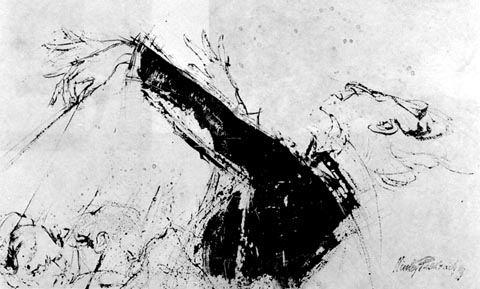
Conductor 1989, Acrylic 24"x36"
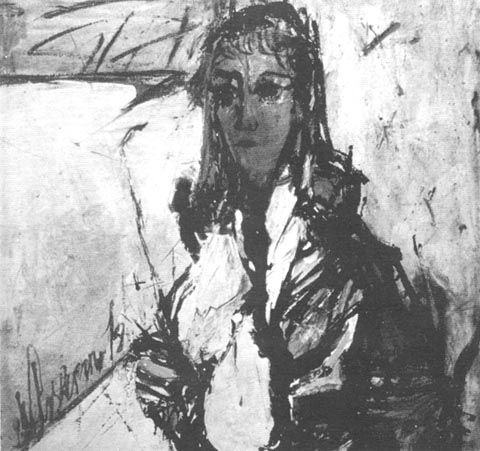
Portrait without a Likeness, 1978, Acrylic 24"x28"
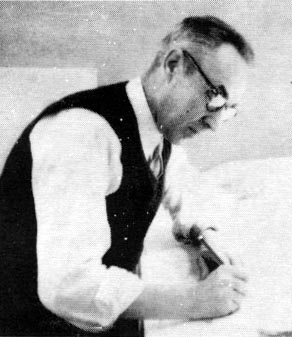
Mykolas Paškevičius
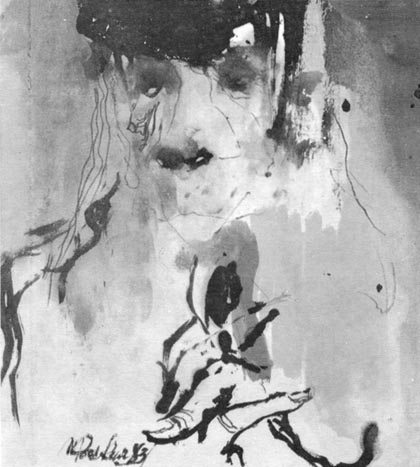
From the Album, 1983, Watercolor, 14"x12"
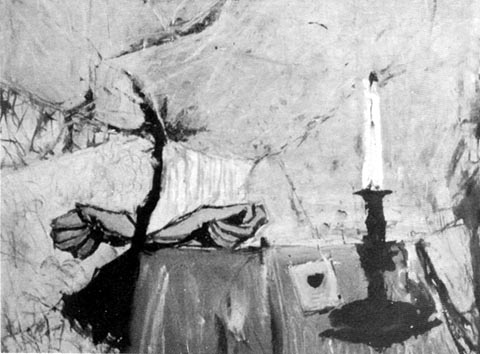
Vehemence, 1945, Oil, 24"x32"
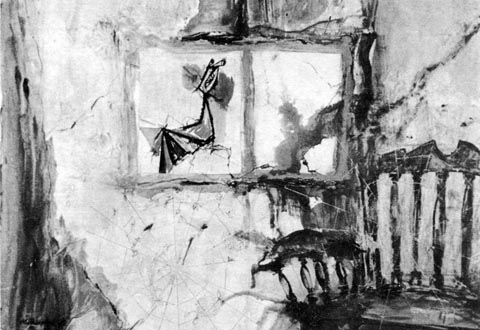
The Attic, 1965, Oil 18"x24"
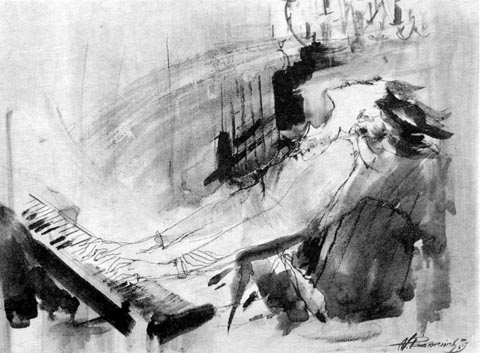
The Woman Pianist, 1977, Watercolor 16"x20"
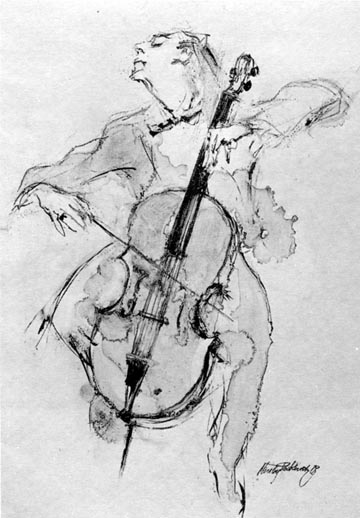
Viola Player, 1979, Acrylic, 26"x18"
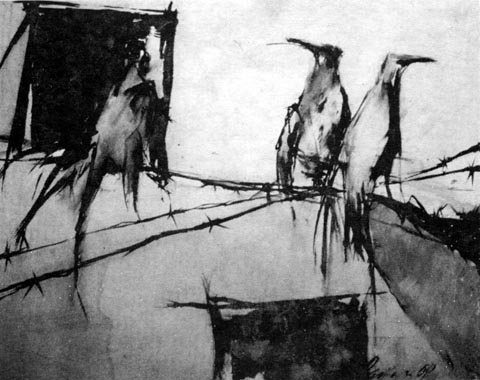
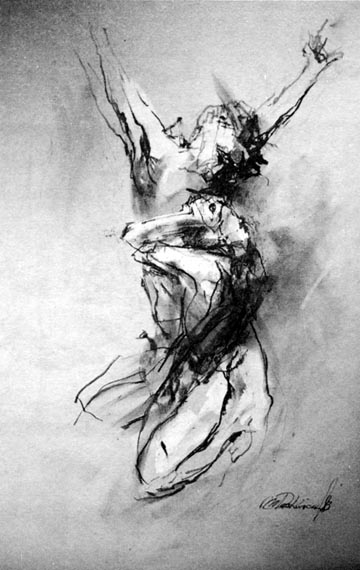
Good-bye, 1990, Acrylic, 24"x18"
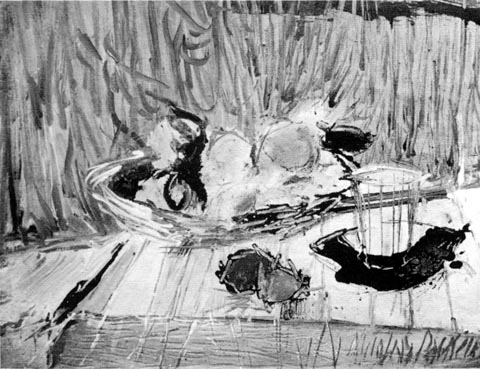
Fruit, 1956, Oil, 18"x24"
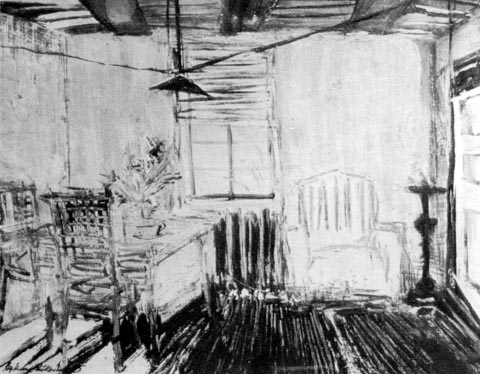
Blue Room, 1944, Oil, 24"x30".